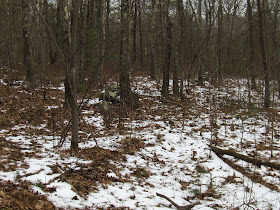I recently visited a site with some stone walls that were on the horizon and had the thought that those walls could be changing how light falls across the site. I'll call this "padding" the horizon. Here is how the idea came up.
There is a big conservation land in Upton, north of Grafton Rd. In the past I found rock piles along one tributary brook in there (see here and here) , and wanted to go back and cement my understanding of the upper and lower areas I saw on different occasions. The blue outline is correct and there are a number of different clusters of rock piles in there.
With my wife along, we headed north from the entrance at "Oak Knoll Ln" (right of center at the bottom) until we came to the brook, and then explored up along it. It should come as no surprise that there are rock piles up along in there.
The first thing you see is a group of three short stretches of stone wall, lined up as if they were all one wall. Here is the first
Here is the 2nd and third in the distance. Note a trail following along.
Closeup of 2nd
closer view of 3rd
view back towards the 2nd. I noticed a boulder at the center of the picture, in the background but capable of throwing a shadow onto these walls.
[If you click in to examine this photo, you can see some interesting trail highlights with the snow. It confirms that the standing stone back there is part of the site]
Then some pretty damaged piles:
A couple of typical burial mounds (I assume because of the conspicuous hollow and vague rectangular shape):
Some of the piles were only a few rocks shy of being "short stretches of wall":
The main features of interest were the many short stretches of wall. Here was another:
I was having trouble telling one bit of wall from another. Was it three or four examples or perhaps twice that number? Here is the one I want to talk about:
I was babbling about how these walls could make shadows, and tune the moment when the light appears over the hill.
I was explaining to my wife, how this wall would be on the horizon if you were below (where most of the rock piles are located). Here is one end of this neat "horizon" wall:
At the other end, a pretty noticeable little enclosure. A place to sit and watch the play of light?
Anyway, you can see how this wall could be on the horizon from below. It only appears for a short stretch perhaps because that was the only bit of horizon that needed tuning. Or perhaps it is simply about the wall making a nice shadow with something else? Have you ever seen the stone wall get taller as it crosses a height of land? [I know I have pictures of this but cannot find them at the moment] I never had a hypothesis about why. Now I can at least suppose: enhancing the high point changes its shadow.
So there were other little bits of wall in there and lots of weirdness under foot (look closely at the right hand side of the photo -right click to magnify):
I could not tell if I was re-photoing the same short walls:
Please note the notch and short extension of the wall at the far end.
Certainly an interesting place. I was looking for some explanation for the short stretches and concluded that: once their job is done there is no reason to continue the wall. What is the job? Maybe something to do with light.



















The way the snow highlights old trails is certainly one of the more important things to notice. I usually don't until I get home and am looking over the photos I took. For example, in a closeup view of the photo with "weirdness under foot", it is hard not to see ghostly figures moving about the scene.
ReplyDeleteThanks for getting me to think about shadows and light (and snow: with no camera on me I missed an opportunity to capture a wind driven snow mostly in the spaces between stones, looking much like rattlesnake skin but covered completley by the heavy snow that covered it all up that night)
ReplyDeletehttp://wakinguponturtleisland.blogspot.com/2017/02/light-and-shadow-and-worlds-oldest.html
I seriously recommend looking at the picture here:
ReplyDeletehttp://rockpiles.blogspot.com/2007/02/see-through-stone-wall-at-high-point.html?m=1
There can be little doubt that manipulation of light and shadow was a consequence of such structures. So it is hard not to project that into the mind of the original builder.